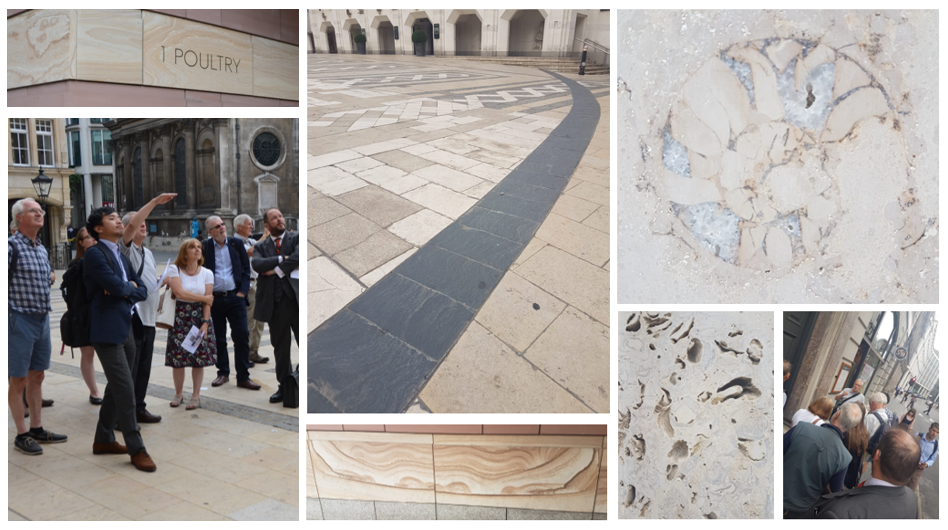What do you do the evening after England are knocked out of the football World Cup?
THE GUILDHALL GUIDED WALK 12 July 2018
What do you do the evening after England are knocked out of the football World Cup? Why you go on an extremely interesting walk looking at “Six Centuries of Building Stones around the Guildhall” in the City of London, that’s what you do!
Superbly organised by Beth at the PESGB and expertly led by Dave Wallis (Marelambis Ltd.), myself and eight fellow PESGB members spent a very enjoyable couple of hours in warm sunshine looking at a wide variety of building stone around the Guildhall area. Yes there is a lot of Portland Stone to be seen on the buildings, but there is so much more to see. Ranging from the Jurassic Collyweston Slate of the Guildhall roof (although it is actually a cross-bedded sandy limestone!) and the Kentish Lower Greensand Ragstone of its walls to the Sardinian Beige Granite, the Forest of Dean Old Red Sandstone and the Jurassic Helidon Sandstone from Queensland, Australia of the striking No. 1 Poultry building.
Drawing on notes from Dr Ruth Siddall of UCL and the work of Dr Eric Robinson formerly of UCL, Dave led a very informative walk of both the history and the geology of the building stones. In addition, some of my fellow PESGB members added interesting and amusing anecdotes.
Personal highlights include the aforementioned No. 1 Poultry (which was completed in 1997 and was Grade II listed in 2016, making it the youngest listed building in England), Guildhall (built between 1411 and 1440) and Guildhall Yard, and the magnificent reception wall at No. 20 Gresham Street which is clad in softly sculpted Pleistocene travertine “Este Cream” limestone from Tivoli near Rome, Italy.
The Jura Yellow or Jura Glebe limestone of the Pizza Express building in Milk Street deserves a mention for the magnificent, well preserved Middle Kimmeridgian macrofossils seen on the walls and pillars of the building, as do the very large K-feldspar phenocrysts and rosettes of black schorl tourmaline of the Dartmoor granite that are used for the foundation stones of Goldsmith’s House.
If you have the opportunity I would highly recommend this walk and would like to thank Dave and Beth for helping me recover from England’s loss against Croatia the previous evening.
One last thing: may I suggest that you download for free the “London Pavement Geology” app that Dave and Ruth have developed. It is an excellent app and website that provides a searchable collection of rock samples visible from the pavement. It has recently been expanded to include sites across the UK and is part sponsored by the PESGB.
Mick Caulfield


